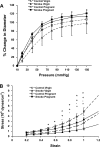Cigarette exposure induces changes in maternal vascular function in a pregnant mouse model
- PMID: 20164208
- PMCID: PMC2867518
- DOI: 10.1152/ajpregu.00274.2009
Cigarette exposure induces changes in maternal vascular function in a pregnant mouse model
Abstract
Smoking is associated with multiple adverse pregnancy outcomes, including fetal growth restriction. The objective of this study was to determine whether cigarette smoke exposure during pregnancy in a mouse model affects the functional properties of maternal uterine, mesenteric, and renal arteries as a possible mechanism for growth restriction. C57Bl/CJ mice were exposed to whole body sidestream smoke for 4 h/day. Smoke particle exposure was increased from day 4 of gestation until late pregnancy (day 16-19), with mean total suspended particle levels of 63 mg/m(3), representative of moderate-to-heavy smoking in humans. Uterine, mesenteric, and renal arteries from late-pregnant and virgin mice were isolated and studied in a pressure-arteriograph system (n = 23). Plasma cotinine was measured by ELISA. Fetal weights were significantly reduced in smoke-exposed compared with control fetuses (0.88 +/- 0.1 vs. 1.0 +/- 0.08 g, P < 0.02), while litter sizes were not different. Endothelium-mediated relaxation responses to methacholine were significantly impaired in both the uterine and mesenteric vasculature of pregnant mice exposed to cigarette smoke during gestation. This difference was not apparent in isolated renal arteries from pregnant mice exposed to cigarette smoke; however, relaxation was significantly reduced in renal arteries from smoke-exposed virgin mice. In conclusion, we found that passive cigarette smoke exposure is associated with impaired vascular relaxation of uterine and mesenteric arteries in pregnant mice. Functional maternal vascular perturbations during pregnancy, specifically impaired peripheral and uterine vasodilation, may contribute to a mechanism by which smoking results in fetal growth restriction.
Figures



Similar articles
-
Maternal vascular responses to hypoxia in a rat model of intrauterine growth restriction.Am J Physiol Regul Integr Comp Physiol. 2016 Dec 1;311(6):R1068-R1075. doi: 10.1152/ajpregu.00119.2016. Epub 2016 Oct 19. Am J Physiol Regul Integr Comp Physiol. 2016. PMID: 27760732
-
Pregnancy-induced alterations of vascular function in mouse mesenteric and uterine arteries.Biol Reprod. 2003 Mar;68(3):1072-7. doi: 10.1095/biolreprod.102.009886. Biol Reprod. 2003. PMID: 12604662
-
An animal model of cigarette smoke-induced in utero growth retardation.Toxicology. 2008 Apr 18;246(2-3):193-202. doi: 10.1016/j.tox.2008.01.014. Epub 2008 Jan 30. Toxicology. 2008. PMID: 18316152 Free PMC article.
-
Perinatal complications associated with maternal tobacco use.Semin Neonatol. 2000 Aug;5(3):231-41. doi: 10.1053/siny.2000.0025. Semin Neonatol. 2000. PMID: 10956448 Review.
-
Genetic and epigenetic influences associated with intrauterine growth restriction due to in utero tobacco exposure.Pediatr Endocrinol Rev. 2010 Dec;8(2):94-102. Pediatr Endocrinol Rev. 2010. PMID: 21150839 Free PMC article. Review.
Cited by
-
Single inhalation exposure to polyamide micro and nanoplastic particles impairs vascular dilation without generating pulmonary inflammation in virgin female Sprague Dawley rats.Part Fibre Toxicol. 2023 Apr 23;20(1):16. doi: 10.1186/s12989-023-00525-x. Part Fibre Toxicol. 2023. PMID: 37088832 Free PMC article.
-
Uteroplacental insufficiency programmes vascular dysfunction in non-pregnant rats: compensatory adaptations in pregnancy.J Physiol. 2012 Jul 15;590(14):3375-88. doi: 10.1113/jphysiol.2012.230011. Epub 2012 May 14. J Physiol. 2012. PMID: 22586217 Free PMC article.
-
Maternal smoking and the retinoid pathway in the developing lung.Respir Res. 2012 Jun 1;13(1):42. doi: 10.1186/1465-9921-13-42. Respir Res. 2012. PMID: 22651576 Free PMC article.
-
Low level maternal smoking and infant birthweight reduction: genetic contributions of GSTT1 and GSTM1 polymorphisms.BMC Pregnancy Childbirth. 2012 Dec 26;12:161. doi: 10.1186/1471-2393-12-161. BMC Pregnancy Childbirth. 2012. PMID: 23268570 Free PMC article.
-
Inter- and transgenerational epigenetic inheritance: evidence in asthma and COPD?Clin Epigenetics. 2015 May 1;7(1):53. doi: 10.1186/s13148-015-0085-1. eCollection 2015. Clin Epigenetics. 2015. PMID: 26052354 Free PMC article.
References
-
- Adams EK, Melvin CL. Costs of maternal conditions attributable to smoking during pregnancy. Am J Prev Med 15: 212–219, 1998 - PubMed
-
- Adamson SL, Lu Y, Whiteley KJ, Holmyard D, Hemberger M, Pfarrer C, Cross JC. Interactions between trophoblast cells and the maternal and fetal circulation in the mouse placenta. Dev Biol 250: 358–373, 2002 - PubMed
-
- Albuquerque CA, Smith KR, Johnson C, Chao R, Harding R. Influence of maternal tobacco smoking during pregnancy on uterine, umbilical and fetal cerebral artery blood flows. Early Hum Dev 80: 31–42, 2004 - PubMed
-
- American College of Obstetrics and Gynecologists. Smoking and Women's Health Washington, DC: Am. Coll. Obstet. Gynecol., 1997. (Educational Bulletin 240)
-
- Anonymous. Tobacco use among adults—US 2005. Morbidity Mortality Weekly Rep 42: 1145, 2006 - PubMed
Publication types
MeSH terms
Substances
Grants and funding
LinkOut - more resources
Full Text Sources
Medical

